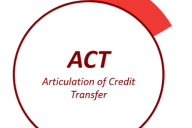You have /5 articles left.
Sign up for a free account or log in.
Regular readers of the “Beyond Transfer” blog don’t need me to describe the huge problems caused by transfer students’ credits not transferring as applying to degree requirements, or not transferring at all, and how credit transfer problems can harm higher education equity. This post is about why articulation agreements aren’t the final solution to these problems and what can be done instead to help credit transfer.
How many times have you heard that credit transfer problems can be solved by establishing more articulation agreements? If you’re not familiar with this term, articulation agreements are essentially contracts by which two or more institutions agree how course credits will transfer among them. For example, three credits for Institution A’s Psychology 101 (Introductory Psychology) will count as three credits for Institution B’s Psychology 1000 (Introductory Psychology) if a student who has taken Psychology 101 transfers from Institution A to B.
So, all we need do is set up lots of articulation agreements with equivalencies for lots of courses and students’ credits will transfer effectively to their new institutions, correct?
Unfortunately, there are numerous problems with this strategy. Though setting up articulation agreements is widely perceived as a great solution for ensuring credit transfer, and many newspaper articles tout the public signing of such agreements, this strategy is like chasing a pot of gold that is supposed to be at the end of a rainbow: Though other people seem to be doing it, no matter how long you search for the gold, you never seem to get it. As Judy Garland sings in The Wizard of Oz, “Birds fly over the rainbow. Why then, oh, why can’t I?” The answer is that, actually, no one is getting to the end of the rainbow. Not the birds, nor any other animals—articulation agreements can solve part of the credit transfer problem, but by no means all of it, and they never will. Let me explain why, using examples from the most common kind of transfer: vertical transfer (transfer from associate to bachelor’s programs).
- Problem 1: The Numbers of Articulation Agreements Needed. Let’s start with some math. Let’s suppose that Community College A has 20 different majors, and that 95 percent of its students transferring to bachelor’s programs transfer to one of just five bachelor’s colleges. That means that, to cover 95 percent (note: not 100 percent) of its students transferring out, Community College A needs to have 20 x 5 = 100 articulation agreements. Each one of these agreements likely needs the involvement of several community college faculty and staff, as well as several at the partner institutions, all of whom must meet with each other, usually multiple times, to negotiate what equivalencies the articulation agreement will contain. In addition, each agreement at each institution likely needs to pass through several levels of approval (e.g., the major’s department, the college’s faculty senate and the college’s provost and president). Those of you with experience with faculty negotiations will know or can guess how long just the faculty negotiations can take, and approval by the official bodies can only happen at the (widely spaced) scheduled meetings of those bodies (which don’t occur during intersessions or summers), and only with the proper advance notice of agenda items. It is no wonder, then, that each articulation agreement can take two years or more from inception to final approval, and that most colleges work on articulation agreements for only a small proportion of their students’ potential transfer paths. The fact that almost one-third of transfer students transfer across state lines, and that students transfer between all types of institutions, makes establishing the number of articulation agreements needed even more challenging.
- Problem 2: Conflicts of Interest. Another problem with articulation agreements has to do with the fact that these agreements are usually constructed by faculty, often faculty who are the most qualified in the agreement’s discipline (because they teach the courses covered by the agreement). This means that a given articulation agreement is likely to most affect the work lives of precisely those faculty doing the negotiations. For example, if College B is considering giving introductory psychology credit for College A’s Introductory Psychology course, then it is likely that College A’s Professor X and College B’s Professor Y, both of whom teach Introductory Psychology, will be working on the articulation agreement. This agreement, if made, could encourage students to take Professor X’s course but not Professor Y’s. Then Professor Y may have insufficient enrollment for their class and be asked to teach another, less familiar course. Not making the agreement would have the opposite effects. The faculty negotiating the articulation agreements are likely to have conflicts of interest. Faculty’s possible conflicts of interest should be recognized and, if possible, mitigated. This is how conflicts of interest are handled in many other professions, such as in business, law and medicine. This conflict of interest does not just apply to faculty. If an institution’s funding is dependent on its enrollment, which is the case for most institutions, then everyone at the institution has an interest in maximizing enrollment. And in the short term, that means denying credit transfer. Transfer students whose credits have been denied have to take extra courses, and so, in the short term, denying credits seems likely to provide more enrollment to an institution. Further, it’s been effectively argued that more selective bachelor’s institutions have more power within the higher education ecosystem, and so are more able to reject transferred credits and harm transfer students. In the end, each institution is doing what it can to further its own interest. But students whose credits don’t transfer are more likely to drop out, and so, in the long term, may not provide more total enrollment after all. Denying credit transfer may be only in an institution’s short-term interest.
- Problem 3: Maintenance and Communication. Even if an articulation agreement is constructed efficiently and effectively, if just one course changes in the agreement, a new negotiated agreement and new approvals may be needed. There is also the problem of these agreements being properly memorialized and communicated to all who need to know about them. Several studies have documented significant inadequacies in this.
This is not to say that all articulation agreements are worthless. Far from it. Agreements that can be done expeditiously and that apply to many students are worth the effort. A subset of such effective agreements consists of dual-admission programs, such as the City University of New York’s Justice Academy, which admit students to both a community and a bachelor’s college, with a single curriculum, so that technically transfer isn’t even necessary.
If credit transfer problems can’t all be solved by articulation agreements, then what else can help? There are at least three types of useful strategies:
- The incentive structures for institutions can be changed.
- Institutions of higher education (IHEs) can be rewarded (by public commendation and/or by increased state funding) for their former students’ success after transferring out, instead of only for currently enrolling students. In the case of vertical transfer, community colleges can be rewarded for their students transferring to bachelor’s programs and graduating, and thus incentivized to help their students progress in the vertical transfer pipeline.
- Public bachelor’s-granting IHEs’ funding can increase, instead of according to enrolled student full-time equivalents, by how advanced a student is, with a bonus if the student graduates. This would help fund the smaller (versus introductory) courses that transfer students are more likely to take, and would provide an incentive for IHEs to admit and support transfer students and their credits.
- Authorities other than IHE members with potential conflicts of interest can make credit transfer decisions.
- All credits from institutions with a certain level of accreditation can transfer in as at least elective credits. Further, subject matter experts external to an institution, state or system offices, and/or AI can decide or contribute to decisions regarding how credits will transfer.
- General education requirements can be set for all the IHEs in a system, a state or the country such that students can transfer some or all general education courses—with general education credit—to any institution.
However, note that 2a could decrease institutions’ independence, and 2b could decrease their heterogeneity, two traits highly valued in American education and often cited as contributing to American higher education’s world superiority.
- Information can be made easily available to help students choose courses and transfer destinations that will maximize their credit transfer.
- This information would publicly show what specific credit a student will get for a transferred course and what program requirements that transferred course will or won’t satisfy. This public information would provide an incentive for enrollment-seeking colleges to present themselves as transfer-friendly (i.e., as giving transfer credit). Such is the strategy underlying CUNY’s Transfer Explorer website (CUNY T-Rex), which has now had over 240,000 unique users, with a new national version, called simply Transfer Explorer, on the way.
Even adopting every one of the above strategies will not fix all the credit transfer problems. There is no such solution. But, as described in this post, there are actions we can take that will help. What we should not do is assume that the time-consuming, enervating strategy of making articulation agreements is all we need to do. That is not a road to the pot of gold at the end of the rainbow, but instead to a never-ending expenditure of time and money that will leave a large percentage of students underserved. We should establish articulation agreements for situations in which the agreements cover large numbers of students and when establishing them can be done expeditiously. But other, perhaps politically harder, actions need to be taken also.
“Somewhere over the rainbow, skies are blue, and the dreams that you dare to dream really do come true.”


